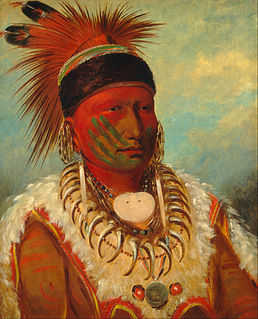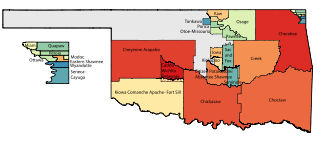Programs and economic development
The tribe issues its own vehicle tags and operates the Bah-kho-je Housing Authority. They own a truck stop, a gas station, a smoke shop, a bingo hall, an off-track wagering facility, and a casino. The estimated annual economic impact of the Iowa Tribe of Oklahoma was $10,343,000 in 2011. [1] The tribe operates the Cimarron Casino in Perkins, the Iowa Tribe Smokeshop in Coyle, and the Ioway Casino Resort in Chandler. [6]
The Bah-Kho-Je Journal is a newspaper published by the tribe for enrolled members. [7] The tribe also owns BKH Solutions, a SBA 8(A) certified company providing trucking, construction, environmental, archaeological, and energy services and consulting. [8] They have their own tribal police department and Tah-Je Do-Weh Che Child Development and Head Start program. [9]
The tribe owns its own Bah-Kho-Je Gallery that represents Iowa artists, such as Jean Bales (Iowa), David Kaskaske (Iowa-Otoe-Missouri), and Daniel Murray (Iowa/Otoe), as well as artists from related tribes, such as Mars Biggoose (Ponca), Gina Gray (Osage Nation), and others. The gallery was based in Guthrie, Oklahoma, but is now located in the Iowa tribal complex in Perkins. [10]
History
The Iowa, or Ioway, originated in the Great Lakes region. They are thought, along with the Ho-Chunk, Otoe, and Missouria tribes, to have once been a single tribe. In the 16th century, the Iowa, Otoe, and Missouria broke away from that tribe and moved to the south and west. [13] The first recorded contact between the Iowa and Europeans was in 1676, in Green Bay, Wisconsin, where they lived among the Ho-Chunk people. [2]
Traditionally, Iowa society was divided into two moieties, the Buffalo and the Bear clans, who would govern the tribe on an alternating, semiannual basis. [2]
In face of European-American encroachment, the Iowa moved east in what is now Iowa and Missouri, but in 1839 the tribe ceded their lands and moved to the Ioway Reservation on the Kansas-Nebraska border. There factionalism broke out between the mixed blood and full blood Iowas. The mixed bloods advocated assimilation, while the full bloods wanted to follow their traditional way of life. [2]
In the attempt to preserve their traditions, the full blood faction of the Iowa Tribe began moving into Indian Territory in 1878. They were given lands within the Sac and Fox Reservation in 1883. Their collective tribal landholdings were broken up by the Dawes Act and, in 1890, individual land was allotted by the Cherokee Commission to 109 tribal members. [14] [2]
The Curtis Act of 1898 dismantled tribal government, but the tribe was able to reorganize under the Oklahoma Indian Welfare Act of 1936, as the Iowa Tribe of Oklahoma. They ratified a constitution and by-laws in 1937. [2]
The Missouria or Missouri are a Native American tribe that originated in the Great Lakes region of what is now the United States before European contact. The tribe belongs to the Chiwere division of the Siouan language family, together with the Iowa and Otoe.
The Hocągara (Ho-Chungara) or Hocąks (Ho-Chunks) are a Siouan-speaking Native American Nation originally from Wisconsin and northern Illinois. Due to forced emigration in the 19th century, they now constitute two individual tribes; the Ho-Chunk Nation of Wisconsin and the Winnebago Tribe of Nebraska. They are most closely related to the Chiwere peoples, and more distantly to the Dhegiha.

Pawnee is a city and county seat of Pawnee County, Oklahoma, United States. The town is northeast of Stillwater at the junction of U.S. Route 64 and State Highway 18.

Perkins is a city in southern Payne County, Oklahoma, United States. The population was 2,831 at the 2010 census, an increase of 24.6 percent from the figure of 2,272 in 2000. The name is derived from Walden Perkins, a congressman who helped establish the local post office. The Iowa Tribe of Oklahoma is headquartered here.

The Iowa, also known as Ioway, and the Bah-Kho-Je or Báxoje are a Native American Siouan people. Today, they are enrolled in either of two federally recognized tribes, the Iowa Tribe of Oklahoma and the Iowa Tribe of Kansas and Nebraska.

The Sac and Fox Nation is the largest of three federally recognized tribes of Sauk and Meskwaki (Fox) Indian peoples. Originally from the Lake Huron and Lake Michigan area, they were forcibly relocated to Oklahoma in the 1870s and are predominantly Sauk.

The Otoe are a Native American people of the Midwestern United States. The Otoe language, Chiwere, is part of the Siouan family and closely related to that of the related Iowa, Missouria, and Ho-Chunk tribes.

Delaware Nation, also known as the Delaware Tribe of Western Oklahoma and sometimes called the Absentee or Western Delaware, based in Anadarko, Oklahoma is one of three federally recognized tribes of Delaware Indians in the United States, along with the Delaware Indians based in Bartlesville, Oklahoma and the Stockbridge–Munsee Community of Wisconsin. Communities also reside in Canada.

The Iowa Tribe of Kansas and Nebraska is one of two federally recognized tribes of Iowa people. The other is the Iowa Tribe of Oklahoma.

Chief Shaumonekusse was a leader of the Otoe Native American tribe in the early 19th century. The Otoe are a Central Plains tribe, closely related to the Ioway, Missouria, Ho-Chunk, and Winnebago.

The Otoe–Missouria Tribe of Indians is a federally recognized tribe, located in Oklahoma. The tribe is made up of Otoe and Missouria peoples. Their language, the Chiwere language, is part of the Siouan language family.
Chiwere is a Siouan language originally spoken by the Missouria, Otoe, and Iowa peoples, who originated in the Great Lakes region but later moved throughout the Midwest and plains. The language is closely related to Ho-Chunk, also known as Winnebago.
Truman Washington Dailey, also known as Mashi Manyi and Sunge Hka, was the last native speaker of the Otoe-Missouria dialect of Chiwere (Baxoje-Jiwere-Nyut'achi), a Native American language. He was a member of the Otoe-Missouria Tribe of Indians.

Native American tribes in the U.S. state of Nebraska have been Plains Indians, descendants of succeeding cultures of indigenous peoples who have occupied the area for thousands of years. More than 15 historic tribes have been identified as having lived in, hunted in, or otherwise occupied territory within the current state boundaries.

Several Native American tribes within the United States register motor vehicles and issue license plates to those vehicles.

The Iowa Reservation of the Iowa Tribe of Kansas and Nebraska straddles the borders of southeast Richardson County in southeastern Nebraska and Brown and Doniphan Counties in northeastern Kansas. Tribal headquarters are west of White Cloud, Kansas. The reservation was defined in a treaty from March 1861. Today the tribe operates Casino White Cloud on the reservation.
Ocooch Mountains are a place name for the Western Upland area of Wisconsin also known as the Driftless Region, meaning un-glaciated, lacking glacial drift or the Paleozoic Plateau, referring to a geologic era, Greek for "ancient life". The lack of glaciated terrain accounts for high hills, bluffs, and ridges. The Chippewa, Black, La Crosse, Kickapoo, Baraboo, Lemonweir, Pine, Wisconsin, Grant, Platte and Pecatonia rivers and their tributaries create deeply eroded valleys that contrast the nearby peaks. One dramatic example is Wildcat Mountain State Park. The Baraboo Range anchors the eastern edge where the Wisconsin River turns and runs through the area to the Mississippi River. The Baraboo Range is a monadnock in Sauk County and a National Natural Landmark formed 1.6 billion years ago featuring Devil's Lake, an endorheic lake.

American Indians of Iowa include numerous Native American tribes and prehistoric cultures that have lived in this territory for thousands of years. There has been movement both within the territory, by prehistoric cultures that descended into historic tribes, and by other historic tribes that migrated into the territory from eastern territories. In some cases they were pushed by development pressure and warfare.

Oklahoma Tribal Statistical Area is a statistical entity identified and delineated by federally recognized American Indian tribes in Oklahoma as part of the U.S. Census Bureau's 2010 Census and ongoing American Community Survey. Many of these areas are also designated Tribal Jurisdictional Areas, areas within which tribes will provide government services and assert other forms of government authority. They differ from standard reservations, such as the Osage Nation of Oklahoma, in that allotment was broken up and as a consequence their residents are a mix of native and non-native people, with only tribal members subject to the tribal government. At least five of these areas, those of the so-called five civilized tribes of Cherokee, Choctaw, Chickasaw, Creek and Seminole, which cover 43% of the area of the state, are formally recognized as reservations by federal treaty, and thus not subject to state law or jurisdiction for tribal members.
Benjamin Arkeketa, also called Thinga-Ja-Bus-Ka, was an American painter from the Oto-Missouria Tribe. He was a member of the "Che" Buffalo Clan, and his paternal great-great-grandfather was Chief George Arkeketa. Influenced by Brummett Echohawk and Acee Blue Eagle, Arkeketa was known for his paintings related to his tribal archaeology and ethnology as well as Christian philosophy.
















